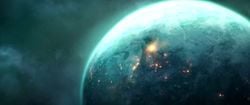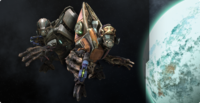Balaho
From Halopedia, the Halo wiki
| Balaho | |
|---|---|

| |
| Astrographical | |
|
System: |
|
|
Orbiting: |
|
|
Orbital position: |
Fifth planet[1] |
|
Moon(s): |
|
| Physical | |
|
Gravity: |
0.709 G[1] |
|
Atmosphere: |
|
|
Surface temperature: |
-33°C to 5°C (-27°F to 41°F)[1] |
| Societal | |
|
Demonym: |
Balahoan[3] |
|
Species: |
|
|
Population: |
|
|
Government: |
|
- "From Balaho came the small methane-breathing Unggoy—the Grunts of the Covenant."
- — The Prophet of Clarity[5]
Balaho is the homeworld of the Unggoy and the fifth planet orbiting the star Tala, a blue supergiant. Hosting an atmosphere featuring large quantities of methane, Balaho is orbited by two natural satellites; Buwan and Padpad. Balaho is a hostile and frigid world, home to brackish tidal flats and numerous swamps,[1][6] growing less hospitable due to environmental degradation.[2]
Regarded as an backwater world, Balaho and the Unggoy were aggressively subjugated into the Covenant in 2142.[7] After being stripped of its resources, Balaho was abandoned aside from a small population when the empire collapsed in 2552,[2] until the Created brought the planet into its fold and sought to bring prosperity to a once volatile and unpredictable world.[4]
History
- "Whereas most species were grafted into the Covenant by faith, or mutual beneficence, the Unggoy were not such. Their kind was brought into the fold by force. And it was by force that they were held captive. Their world had no prayer against our might and majesty. And their peoples were quickly laid low. Many of them brought into subjugation."
- — A San'Shyuum scribe, referring to Balaho's subjugation into the Covenant Empire[8]
The Unggoy evolved on Balaho, eventually achieving a Tier 4 civilization within their home system of Tala. Prior to the activation of the Halo Array in 97,445 BCE, an environmental collapse occurred on Balaho caused by massive global over-industrialization. After the reintroduction of indigenous species following the array's firing, and before it was discovered by the Covenant, Balaho was mainly dominated by disparate Unggoy tribes.[1]
When the Covenant came across the vulnerable Balaho and the Unggoy in 2142,[7][9] most were more than willing to leave their hostile homeworld and join the hegemony.[6] However, others were unwilling to subject to the Covenant and Balaho was ultimately subjugation by the Covenant, with a large fleet arriving over the planet. The reluctant Unggoy quickly ceased their resistance and the Covenant landed to bring the Unggoy into the fold of their empire; the Unggoy surrendered to the imposing Sangheili and Kig-Yar that came to Balaho,[8][6] and the species was aggressively converted into the Covenant and forced into servitude.[7] Once under the severe threat of overpopulation, billions of Unggoy left Balaho to serve the Covenant and fight in the empire's wars, leaving the planet practically empty of life with only a comparatively small population of several hundred million. Covenant tithe fleets stripped Balaho and its moons of their remaining resources, leaving little of value on the planet and hollowing out its moons to feed the assembly forges of the Holy City of High Charity. The Covenant also established a hydro-processing center on Buwan.[2]
However, centuries later, in 2462, the Unggoy initiated the 39th Age of Conflict during the Unggoy Rebellion, revolting against the Covenant throughout High Charity over the mistreatment of their species.[10] The rebellion proved the Unggoy to be tenacious and fierce, their large numbers making them a suitable challenge even for the Sangheili. In response, an Arbiter was appointed to deal with the conflict. Taking a fleet to Balaho, the Arbiter partially glassed the planet, broadcasting the glassing to the Unggoy on High Charity and effectively threatening to exterminate the entire species. Fearing for their kin on their homeworld, the glassing of Balaho led to the species' surrender and the end of the rebellion.[8][7] Although the Unggoy on High Charity leading the rebellion cared little for their home planet itself, they surrendered as they were unwilling to lose the large amount of potential breeding partners that lived there.[6][10] Since the events of the Unggoy Rebellion, Balaho became regarded as a backwater planet and it was avoided by most shipping routes. Although most Unggoy eventually settled on the planets of other species, Balaho was still highly regarded among the Unggoy.[6] Immediately following the Human-Covenant War and the collapse of the Covenant Empire, the Office of Naval Intelligence recorded no off-world transport from Balaho, also noting that Buwan appeared to have been abandoned.[11] The planet was forgotten with most Unggoy living on other worlds and den mothers struggling to maintain Balaho's society.[2]
On October 28, 2558, Cortana claimed the Mantle of Responsibility and broadcast an offer of peace and prosperity to many species of the galaxy. The Unggoy on Balaho responded favorably to this proposition, and in response, they were granted nearly limitless resources by the Created. Crewless ships loaded with advanced technology arrived, along with agricultural support stations being installed in orbit, awaiting eager workers to feed the desperate masses below. Under the new management, stability and a semblance of order were restored to Balaho, along with a newfound purpose. The planet's previously abandoned factories were activated once again, and with their immediate requirements—food, shelter, medicine—met, the planet's Unggoy designers and crafters began to work tirelessly to construct new machines and weaponry based on knowledge the Unggoy had secretly learned over their centuries under the Covenant's rule.[4] Notably, the Balahoan factories have created the Goblin battlesuit.[12][13]
Topography
An unpredictable and dangerous world, Balaho is a mostly frozen planet with temperatures ranging from 33°C to 5°C (-27°F to 41°F).[1] It has two natural satellites, Buwan and Padpad, respectively the primary and secondary satellites.[14] With an atmosphere rating of 5.7, the terrestrial planet has significant amounts of methane in the atmosphere, in addition to carbon dioxide and helium, necessitating that Unggoy wear methane tanks while off-world. This gas forms a largely opaque layer of clouds that prevents much of the world from being seen from orbit.[1][note 1]
The parts of the surface that are not covered by polar ice caps or fresh water are equatorial brackish tidal flats where naturally occurring pillars of fire exist when the planet's methane condenses. Most of the Unggoy live in this area where the cold season is not as harmful to them. The planet is also home to several swamps and dire marshes.[2][6] The world is still recovering from an environmental collapse caused by massive global over-industrialization prior to the activation of the Halo Array.[1] Balaho continues to experience environmental degradation and has become increasingly less hospitable over the centuries. Balaho's severe exploitation by the Covenant has only caused the environment to suffer further.[2] Until the Covenant's arrival, the planet's population was threatened by two consecutive winter seasons, plagues, and a general lack of food.[15] Blue Death is a risk to all Unggoy that were exposed to Balaho's harsh climate.[16]
The planet's hostile conditions and the methane atmosphere of Balaho sustains unusually hardy forms of life,[15] most notably the Unggoy who are believed to have evolved from smaller amphibious primates. Balaho is home to many voracious predators, with the Unggoy evolving to have a rigid exoskeleton lined with spikes and barbs along their body to deter such threats.[7] The luminescent zap-jellies filled the brackish seas of Balaho,[17] with mud wasps and shade crabs being commonly hunted for sport, particularly by Unggoy youth. Balaho is also home to scrub grubs, an arthropodic pest that feeds on machinery.[18] Some methane tanks used by Unggoy resemble the Balahoan octopoda.[3]
Government and society
Balaho is ruled by matriarchal tribes of Unggoy,[1] led by den mothers struggling to maintain their society.[2] In 2142, the Covenant annexed Balaho, aggressively converting the Unggoy and forcing them into servitude.[7] Under the Covenant's rule, Balaho was a backwater world in a vast empire, avoided by most shipping routes. However, infant mortality decreased and life expectancy doubled on Balaho, with geronticide no longer being necessary for the survival of a tribe.[15] Under the Created's control, Balaho has flourished and industry has returned to the planet.[4]
Harsh environments on Balaho moulded the Unggoy into a tenacious, hardy species,[6] with the Unggoy once concerning themselves with food shortages and burning plague victims, until the Covenant's arrival.[15] Balaho is known for its own form of martial arts.[13] While the Unggoy see their world as "ugly, foul, and frozen", many still think fondly of their homeworld.[6] Once home to billions and under the threat of overpopulation, Balaho now maintains a small population of 320 million, with most Unggoy living off-world though many desiring to return.[2]
Behind the scenes
Balaho means "swamp" in Tagalog, a major language in the Philippines. Unggoy means "monkey" in the same language.
Gallery
Ancient Unggoy being reseeded on Balaho by Forerunner machinery
List of appearances
- Halo: The Fall of Reach (First mentioned)
- Halo: The Flood (Mentioned only)
- Halo 3
- Bestiarum (First appearance)
- Halo: Ghosts of Onyx (Mentioned only)
- Halo: Contact Harvest (Mentioned only)
- Halo Legends
- Halo: Combat Evolved Anniversary (Mentioned only)
- Halo 2: Anniversary
- Halo 5: Guardians (Mentioned only)
- Halo Mythos (Mentioned only)
- Halo Wars 2 (Mentioned only)
Notes
- ^ Methane is a powerful greenhouse gas (about 23 times stronger than carbon dioxide), making it very effective at insulating an atmosphere. As such, it is strange that Balaho is so cold when the planet's atmosphere is composed mainly of methane. The most likely explanation is that Balaho is much farther from Tala than most other habitable planets are from their stars and that is warm enough to support life because of its methane atmosphere. This also explains why the planet was not engulfed when Tala expanded into a blue supergiant.
Sources
- ^ a b c d e f g h i j k l m n o p Halo 3, "Bestiarum"
- ^ a b c d e f g h i j k l Halo: Warfleet, p. 55
- ^ a b Halo 4: The Essential Visual Guide, p. 37
- ^ a b c d Halo Waypoint: Canon Fodder - Driving Force
- ^ Halo: Broken Circle, p. 211
- ^ a b c d e f g h Halo Encyclopedia, p. 308 (2011)
- ^ a b c d e f Halo Waypoint: Unggoy
- ^ a b c Halo 2: Anniversary, "Terminal 10"
- ^ Halo Encyclopedia, p. 121 (2011)
- ^ a b Halo: Contact Harvest, p. 151
- ^ Eleventh Hour reports, Part 3
- ^ Halo Waypoint: Canon Fodder - Buzz Generating
- ^ a b Halo Waypoint: Community Update - Haze of Glory
- ^ Xbox Live's Major Nelson: News From Halo Fest
- ^ a b c d Halo Encyclopedia, p. 151
- ^ Halo: Ghosts of Onyx, p. 237
- ^ Halo: Contact Harvest, p. 186
- ^ Halo: Contact Harvest, p. 90





